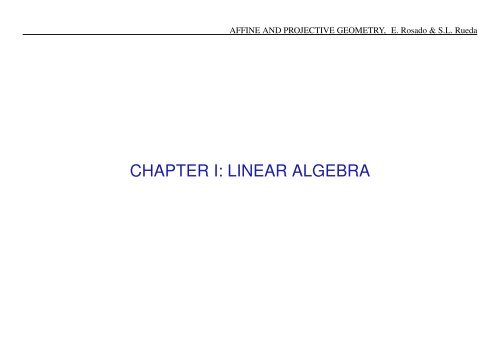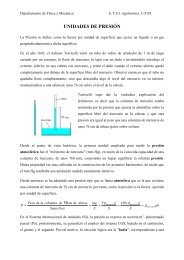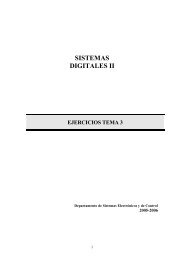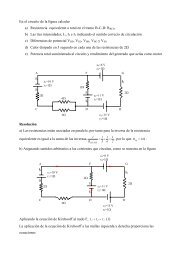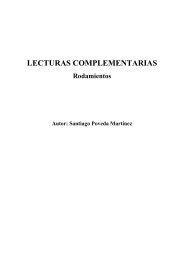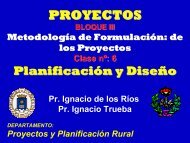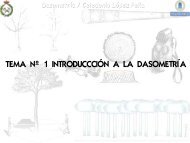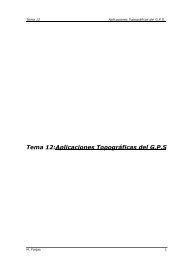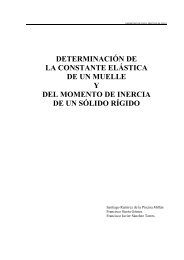CHAPTER I: LINEAR ALGEBRA - OCW UPM
CHAPTER I: LINEAR ALGEBRA - OCW UPM
CHAPTER I: LINEAR ALGEBRA - OCW UPM
You also want an ePaper? Increase the reach of your titles
YUMPU automatically turns print PDFs into web optimized ePapers that Google loves.
AFFINE AND PROJECTIVE GEOMETRY, E. Rosado & S.L. Rueda<br />
<strong>CHAPTER</strong> I: <strong>LINEAR</strong> <strong>ALGEBRA</strong>
AFFINE AND PROJECTIVE GEOMETRY, E. Rosado & S.L. Rueda<br />
1. MATRICES<br />
Let A be a matrix with m rows and n columns, we will say that<br />
A has size m × n.<br />
We will write A = (a ij ) with i = 1, . . . , m, j = 1, . . . , n. That is,<br />
⎛<br />
⎞<br />
a 11 a 12 · · · a 1n<br />
A = ⎜ a 21 a 22 · · · a 2n<br />
⎟<br />
⎝ . . ... . ⎠ .<br />
a m1 a m2 · · · a mn<br />
A squared matrix A is symmetric if a ij = a ji , i = 1, . . . , m, j =<br />
1, . . . , n.
AFFINE AND PROJECTIVE GEOMETRY, E. Rosado & S.L. Rueda<br />
Let A be a squared matrix of size n × n (of order n) with n ≥ 2. We denote<br />
by det(A) or | A | the determinant of A.<br />
Let A ij be the matrix obtained removing row i and column j of A. To compute<br />
the determinant of A we can develop the determinant using the ith row<br />
of A<br />
det(A) = (−1) i+1 a i1 | A i1 | +(−1) i+2 a i2 | A i2 | + · · · + (−1) i+n a in | A in | .<br />
or the jth column of A<br />
det(A) = (−1) 1+j a 1j | A 1j | +(−1) 2+j a 2j | A 2j | + · · · + (−1) n+j a nj | A nj | .<br />
Let A be an m × n matrix. The rank of A is the order of the biggest squared<br />
submatrix of A with non zero determinant. We will write rank(A).
AFFINE AND PROJECTIVE GEOMETRY, E. Rosado & S.L. Rueda<br />
2.SYSTEMS OF <strong>LINEAR</strong> EQUATIONS<br />
Given a system of m linear equations in the variables x 1 , x 2 , . . . , x n :<br />
⎧<br />
a 11 x 1 + a 12 x 2 + · · · + a 1n x n = b 1<br />
⎪⎨<br />
a 21 x 1 + a 22 x 2 + · · · + a 2n x n = b 2<br />
.<br />
⎪⎩ a m1 x 1 + a 12 x 2 + · · · + a mn x n = b m .<br />
where m ≥ 1, the coefficients a ij and the independent terms b i , i = 1, . . . , m,<br />
j = 1, . . . , n are real numbers.<br />
The matrix equation of the system is AX = b<br />
⎛<br />
⎞ ⎛ ⎞ ⎛ ⎞<br />
a 11 a 12 · · · a 1n<br />
x 1<br />
b 1<br />
a<br />
A = 21 a 22 · · · a 2n<br />
⎜<br />
⎟<br />
⎝ . .<br />
... . ⎠ , X = x 2<br />
⎜ ⎟<br />
⎝ . ⎠ , b = b 2<br />
⎜ ⎟<br />
⎝ . ⎠ ,<br />
a m1 a m2 · · · a mn x n b m<br />
where A is the the coefficient matrix, b the matrix of independent terms and<br />
X the matrix of unknowns.
AFFINE AND PROJECTIVE GEOMETRY, E. Rosado & S.L. Rueda<br />
The matrix of the system is<br />
⎛<br />
⎞<br />
a 11 a 12 · · · a 1n b 1<br />
A | b = ⎜ a 21 a 22 · · · a 2n b 2<br />
⎟<br />
⎝ . . ... . . ⎠ .<br />
a m1 a m2 · · · a mn b m<br />
A solution of the system is a list (s 1 , s 2 , . . . , s n ) of real numbers<br />
that transform the equations in identities when substituting the<br />
values x 1 , x 2 , . . . , x n by s 1 , s 2 , . . . , s n respectively.<br />
The solution set of the system is the subset of R n given by<br />
⎛ ⎞<br />
s 1<br />
{(s 1 , s 2 , . . . , s n ) ∈ R n | AS = b} where S = ⎜ s 2<br />
⎟<br />
⎝ . ⎠ .<br />
s n
AFFINE AND PROJECTIVE GEOMETRY, E. Rosado & S.L. Rueda<br />
Rouche Theorem Let us consider a system of linear equations<br />
with n unknowns with matrix equation AX = b. Then, the system<br />
1. has a solution ⇔ rank(A | b) = rank(A),<br />
2. has a unique solution ⇔ rank(A | b) = rank(A) = n.<br />
A system of linear equations with matrix equation AX = b is<br />
homogeneous if b is a matrix of zeros. We write AX = 0.<br />
A homogenous system of linear equations has always the zero<br />
solution and by the Rouche Theorem it has a nonzero solution<br />
(and therefore infinitely many solutions) if and only if rank(A |<br />
b) = rank(A) < n.
AFFINE AND PROJECTIVE GEOMETRY, E. Rosado & S.L. Rueda<br />
3. VECTOR SPACES AND SUBSPACES
AFFINE AND PROJECTIVE GEOMETRY, E. Rosado & S.L. Rueda<br />
A real vector space is a nonempty set V (of elements called vectors) where<br />
two operations are defined.<br />
1. Addition of vectors + : V × V −→ V is an internal operation: ∀u, v ∈ V<br />
then u + v ∈ V . Also ∀u, v, w ∈ V they verify the properties:<br />
a) Commutative. u + v = v + u.<br />
b) Distributive. (u + v) + w = u + (v + w).<br />
c) Zero element. There exists a zero vector 0 in V such that u + 0 = u.<br />
d) Opposite element. ∀u ∈ V , ∃ − u ∈ V such that u + (−u) = 0.<br />
2. Multiplication by scalars (real numbers) · : R × V −→ V is an external<br />
operation: ∀v ∈ V and ∀a ∈ R then av ∈ V . Also ∀u, v ∈ V , ∀a, b ∈ R<br />
verify<br />
a) a(u + v) = au + av<br />
b) (a + b)u = au + bu<br />
c) (ab)u = a(bu) d) 1u = u.
Examples of vector spaces<br />
AFFINE AND PROJECTIVE GEOMETRY, E. Rosado & S.L. Rueda<br />
1. R n = {(a 1 , a 2 , . . . , a n )|a i ∈ R, i = 1, . . . n}, n ∈ N is a real vector space<br />
with the operations:<br />
(a 1 , a 2 , . . . , a n ) + (b 1 , b 2 , . . . , b n ) = (a 1 + b 1 , a 2 + b 2 , . . . , a n + b n )<br />
α(a 1 , a 2 , . . . , a n ) = (αa 1 , αa 2 , . . . , αa n )<br />
con (b 1 , b 2 , . . . , b n ) ∈ R n y α ∈ R. The zero vector is 0 = (0, 0, . . . , 0). The<br />
opposite vector of (a 1 , a 2 , . . . , a n ) is (−a 1 , −a 2 , . . . , −a n ).<br />
2. Given a homogeneous system of linear equations with real coefficients<br />
⎧<br />
a 11 x 1 + . . . + a 1n x n = 0<br />
⎪⎨<br />
a<br />
(∗) 21 x 1 + . . . + a 2n x n = 0<br />
· · ·<br />
⎪⎩ a m1 x 1 + . . . + a mn x n = 0.<br />
with n unknowns. The set of solutions of the system (∗):<br />
W = {(a 1 , a 2 , . . . , a n ) ∈ R n |(a 1 , a 2 , . . . , a n ) is a solution of (∗)} ⊆ R n<br />
is a real vector space.
3. The set of matrices of size m × n (m rows and n columns) with real<br />
elements M m×n (R) is a real vector space with the sum of matrices and<br />
the product of matrices by scalars.<br />
4. The set of the polynomials in x of degree less than or equal to n with<br />
real coefficients R n [x] is a real vector space with the sum of polynomial<br />
and the product of polynomials by scalars.<br />
A polynomial p(x) in R n [x] is<br />
with a 0 , a 1 , . . . , a n ∈ R.<br />
p(x) = a 0 + a 1 x + a 2 x 2 + · · · + a n x n
Definition of vector subspace<br />
Let V be a real vector space.<br />
AFFINE AND PROJECTIVE GEOMETRY, E. Rosado & S.L. Rueda<br />
A nonempty subset U of V is a vector subspace of V if ∀α, β ∈ R and<br />
∀u, v ∈ U it holds:<br />
αu + βv ∈ U.<br />
Equivalently, a nonempty subset U of V is a vector subspace of V if it holds:<br />
1. ∀u, v ∈ U, u + v ∈ U, thus + is an inner operation in U,<br />
2. ∀u ∈ U, ∀α ∈ K, αu ∈ U, thus · is an external operation on U.<br />
Therefore, U is a vector subspace if it is a vector space with the operations<br />
of V .
Examples of vector subspaces<br />
AFFINE AND PROJECTIVE GEOMETRY, E. Rosado & S.L. Rueda<br />
1. Given a vector space V , the sets {0 V } and V are vector subspaces of<br />
V .<br />
2. V = R 3 , U = {(x, y, 0)|x, y ∈ R} is a vector subspace of R 3 .<br />
3. The solution set of a homogeneous system of linear equations with n<br />
unknowns with real coefficients is a vector subspace of R n .<br />
4. Given a nonzero vector u in V , the set<br />
is a vector subspace of V .<br />
U = {au | a ∈ R}
AFFINE AND PROJECTIVE GEOMETRY, E. Rosado & S.L. Rueda<br />
Let V be a real vector space.<br />
A vector u ∈ V is a linear combination of the vectors u 1 , . . . , u n ∈ V if there<br />
exist scalars a 1 , . . . , a n ∈ R such that<br />
n∑<br />
u = a 1 u 1 + . . . + a n u n = a i u i .<br />
Let C be a nonempty subset of V . Then the set of all the linear combinatuions<br />
with vectors of C,<br />
n∑<br />
〈C〉 = { a i u i | a i ∈ R, u i ∈ C}<br />
i=1<br />
is a vector subspace of V which is called the subspace generated by C.<br />
Let C = {(1, 0, 0), (0, 1, 1)} ⊆ R 3 . Then<br />
〈C〉 = {(a, b, b) | a, b ∈ R}.<br />
i=1
AFFINE AND PROJECTIVE GEOMETRY, E. Rosado & S.L. Rueda<br />
The intersection of two subspaces U 1 and U 2 of V<br />
is a vector subspace of V .<br />
U 1 ∩ U 2 = {v | v ∈ U 1 and v ∈ U 2 }.<br />
The subspace 〈C〉 generated by C verifies:<br />
1. C ⊆ 〈C〉.<br />
2. Every subspace of W such that C ⊆ W verifies 〈C〉 ⊆ W .<br />
3. The subspace 〈C〉 coincides with the intersection of all subspaces containing<br />
C.<br />
A vector space V is finitely generated if there exists a finite set of vectors G<br />
such that V = 〈G〉, the set G is a generating set of V .
Let V = R 3 .<br />
AFFINE AND PROJECTIVE GEOMETRY, E. Rosado & S.L. Rueda<br />
1. G 1 = {(1, 0, 0), (0, 1, 0), (0, 0, 1)} is a generating set of R 3 , since every<br />
vector (x 1 , x 2 , x 3 ) ∈ R 3 can be written as<br />
(x 1 , x 2 , x 3 ) = x 1 (1, 0, 0) + x 2 (0, 1, 0) + x 3 (0, 0, 1).<br />
2. Let us check that G 2 = {(1, 1, 1), (1, 1, 0), (1, 0, 0)} is a generating set of<br />
R 3 . Given (x 1 , x 2 , x 3 ) ∈ R 3 , we wonder if there exist λ 1 , λ 2 , λ 3 ∈ R such<br />
that<br />
(x 1 , x 2 , x 3 ) = λ 1 (1, 1, 1) + λ 2 (1, 1, 0) + λ 3 (1, 0, 0)<br />
equivalently if the following system in the variables λ 1 , λ 2 and λ 3 has a<br />
solution<br />
⎧<br />
⎨ λ 1 + λ 2 + λ 3 = x 1<br />
λ<br />
⎩ 1 + λ 2 = x 2<br />
λ 1 = x 3 .<br />
Since the coefficient matrix has rank 3, then Rouche Theorem implies<br />
that for every (x 1 , x 2 , x 3 ) ∈ R 3 the system has a solution.
3. Let us check that G 3 = {(1, 1, 1), (2, 1, 1), (0, 0, 1), (3, 0, 0)} is a generating<br />
system of R 3 . Given (x 1 , x 2 , x 3 ) ∈ R 3 . We wonder if there exist<br />
λ 1 , λ 2 , λ 3 , λ 4 ∈ R such that<br />
(x 1 , x 2 , x 3 ) = λ 1 (1, 1, 1) + λ 2 (2, 1, 1) + λ 3 (0, 0, 1) + λ 4 (3, 0, 0)<br />
equivalently if the following system with unknown variables λ 1 , λ 2 , λ 3 y<br />
λ 4 has a solution ⎧<br />
⎨ λ 1 + 2λ 2 + 3λ 4 = x 1<br />
λ<br />
⎩ 1 + λ 2 = x 2<br />
λ 1 + λ 2 + λ 3 = x 3 .<br />
The coefficient matrix has rank 3 so Rouche’s Theorem allows to say<br />
that for every (x 1 , x 2 , x 3 ) ∈ R 3 the system has infinitely many solutions.
AFFINE AND PROJECTIVE GEOMETRY, E. Rosado & S.L. Rueda<br />
4. G 4 = {(1, 1, −3), (0, 0, 1)} is not a generating set of R 3 . The reason is that<br />
the system<br />
⎧<br />
⎨ λ 1 = x 1<br />
λ<br />
⎩ 2 = x 2<br />
−3λ 1 + λ 2 = x 3<br />
does not have a solution for every (x 1 , x 2 , x 3 ) ∈ R 3 . For example, if<br />
(x 1 , x 2 , x 3 ) = (0, 1, 0) the system has no solution.<br />
We observe in the previous example that the real vector space R 3 is finitely<br />
generated but the generating set is not unique. The natural question is,<br />
how many vectors do we need to generate R 3 ?


